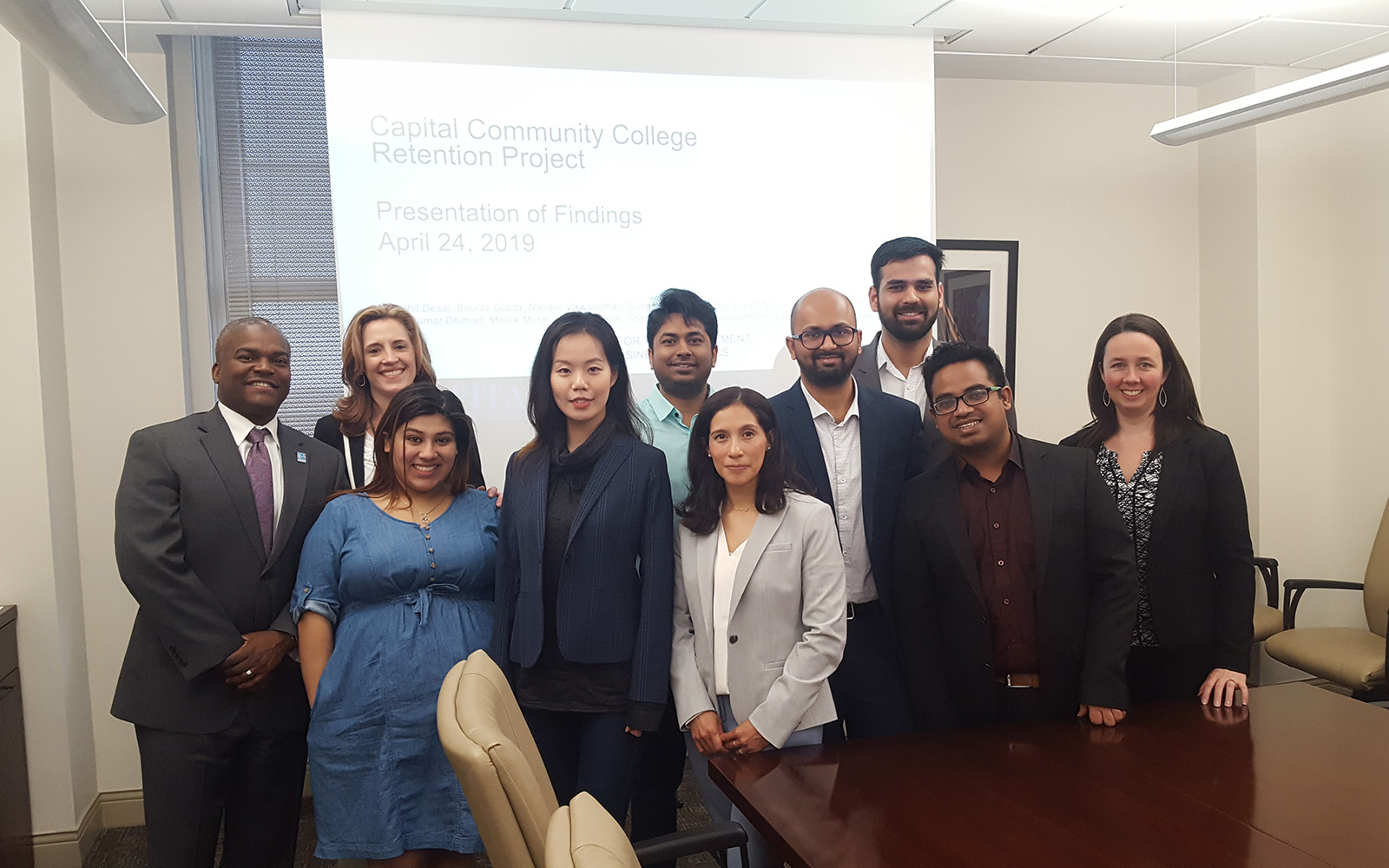
G. Duncan Harris, Interim CEO at Capital Community College, and his team, know the strengths and the struggles that many of their 3,300 students face on the path toward achieving their degrees.But until recently, they didn’t have access to current data analytics analysis to support their beliefs. On April 24, a team of UConn graduate students shared the results of a predictive analytics project, outlining characteristics of CCC students who are most likely to succeed, and those who are at greater risk of dropping out.
The goal in sharing the data is to help CCC boost its fall-to-fall retention rate, which currently hovers around 45 percent. The UConn students’ findings were based on data supplied by CCC, and all student identification remained confidential.
“We hear a lot of stories from individual students, but until now we did not have the aggregate findings from the data analytics,” Harris said.
“The value of this kind of research is immeasurable. We wouldn’t be able to afford to hire a company to do this for us. We are grateful to UConn, our colleagues down the street, for providing this service,” he said. “We are all stakeholders in the success of our community.”
Financial Aid Seems to be Key Factor in Success
The School of Business’ recently created Center for the Advancement of Business Analytics (CABA), connects UConn researchers and students to companies and organizations in Connecticut, and beyond that want to gain insight into their business practices and processes through business analytics. The CCC project was part of that initiative.
Twelve graduate students, all enrolled in UConn’s master’s degree program in Business Analytics and Project Management (MSBAPM), spent about six weeks analyzing five years of data from CCC. They worked under the direction of Professors Jennifer Eigo and David Bergman.
The UConn students found that CCC male students, students who don’t have financial aid, and part-time students were less likely to remain in college. Also, they discovered that the retention rate for majors varied significantly, with nursing having the highest retention rate, at 92 percent.
In addition, the UConn students found that students from non-traditional high schools (whether private, vocational, religious, magnet or home schooled) fared well at Capital. They were surprised that student age and distance of the commute didn’t appear to have a statistically significant impact on success.
The UConn students, in their consulting role, offered a number of suggestions to CCC administrators, such as augmenting the offering of financial advising to students who aren’t eligible for aid, considering more flexible class times for those who are working, studying which advisers work best with specific student populations, and adding additional support for students in the higher-risk categories.
UConn’s Yuly Susaya, who will graduate in May and has accepted a job with Slalom Consulting in Hartford, said she enjoyed gathering, analyzing and presenting the team’s findings.
“I appreciated this project because of the impact we’ll be making at Capital Community College, in Hartford, and in the state of Connecticut,” she said. “I loved working with my team and with this data. It really encompassed all aspects of our BAPM program. They’re our clients and working for them allowed us to put our techniques into practice. They’re doing a lot of great stuff at CCC already, and we hope we were able to offer some guidance as they decide where to direct their efforts now.”
UConn student Sourav Gupta said he enjoyed the project enormously, especially untangling the ‘real world’ data and working toward a solution for an important problem.
“I enjoyed the challenge and knowing it had direct impact,” he said. “Education is very important for people to move up in their lives. We wanted to help the Capital team target those high-risk students and offer them help so they would stay in school.”
Jahydeliss Minano, a business major at CCC, worked as a liaison between the two colleges. Minano, a self-described numbers enthusiast, was instrumental in gathering the data and took on the task in addition to working full-time and attending college.

Data Will Be Helpful for CCC Grant Applications
Harris, who was joined at the presentation by other senior administrators and members of CCC’s Strategic Enrollment Management Team, said the information was extremely helpful as the college works on its strategic plan and applies for a new round of federal grants.
“I don’t know if you’re aware of what you’ve given us,” he told the UConn students excitedly. “You have given us a case for greater support. We’ve been focusing efforts on ensuring students maintain their federal financial aid and exploring the impact of employment on student retention.”
Administrators from both colleges are considering extending the partnership. UConn students would like to gather more data, such as how many hours the average student is working, whether marital status impacts retention, how dependents influence completion of college, and the most common reasons students leave CCC.
“This partnership is phenomenal,” said Miah LaPierre-Dreger, CCC’s Interim Dean of Academic Affairs. “A lot of community colleges across the country would love to have this kind of data about their programs.”
“I think our students were really inspired by the idea of working collaboratively with Capital Community College,” said Eigo, who is also the associate director of CABA. “Whereas much of the business world is about the bottom line and financial success, this project was about using analytics skills to make a difference in people’s lives, specifically by identifying the factors that are important to keeping students enrolled as they work towards their degree.”
Harris praised the team effort and said the information and collaboration was good for students, for Greater Hartford, and for the state.
“You’ve affirmed that we’re on the right track with the recent student-success strategies we’ve deployed and provided a data-informed platform for the launching of others,” he said. “The spirit of collegiality and support for our shared community exhibited in this project was phenomenal.”